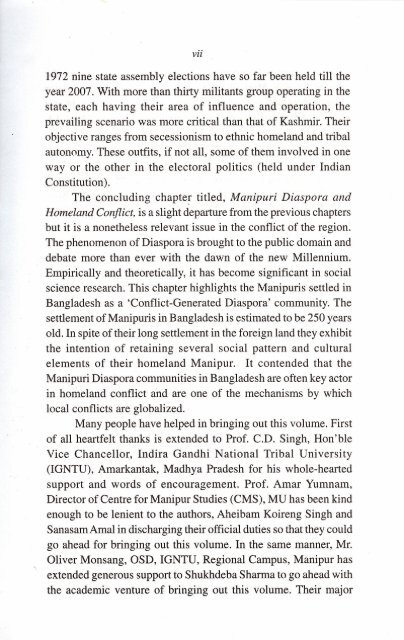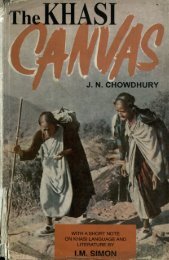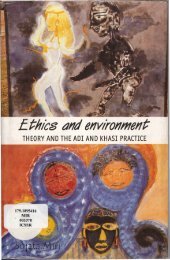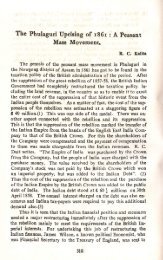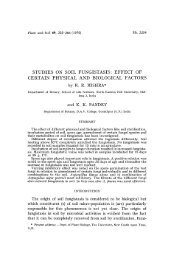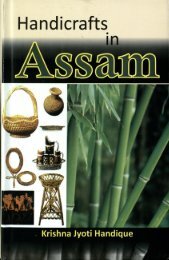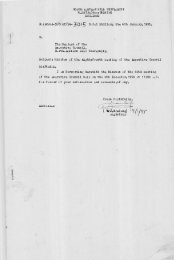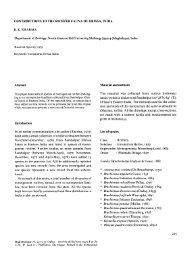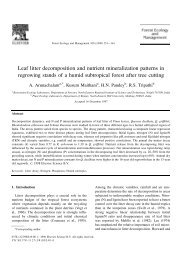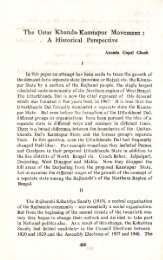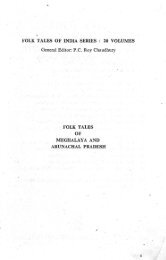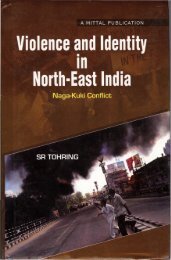Removing the veil.pdf - DSpace@NEHU
Removing the veil.pdf - DSpace@NEHU
Removing the veil.pdf - DSpace@NEHU
You also want an ePaper? Increase the reach of your titles
YUMPU automatically turns print PDFs into web optimized ePapers that Google loves.
vii<br />
1972 nine state assembly elections have so far been held till <strong>the</strong><br />
year 2007. With more than thirty militants group operating in <strong>the</strong><br />
state, each having <strong>the</strong>ir area of influence and operation, <strong>the</strong><br />
prevailing scenario was more critical than that of Kashmir. Their<br />
objective ranges from secessionism to ethnic homeland and tribal<br />
autonomy, These outfits, if not all, some of <strong>the</strong>m involved in one<br />
way or <strong>the</strong> o<strong>the</strong>r in <strong>the</strong> electoral politics (held under Indian<br />
Constitution).<br />
The concluding chapter titled, Manipuri Diaspora and<br />
Homeland Conflict, is a slight departure from <strong>the</strong> previous chapters<br />
but it is a none<strong>the</strong>less relevant issue in <strong>the</strong> conflict of <strong>the</strong> region.<br />
The phenomenon of Diaspora is brought to <strong>the</strong> public domain and<br />
debate more than ever with <strong>the</strong> dawn of <strong>the</strong> new Millennium.<br />
Empirically and <strong>the</strong>oretically, it has become significant in social<br />
science research. This chapter highlights <strong>the</strong> Manipuris settled in<br />
Bangladesh as a 'Conflict-Generated Diaspora' community. The<br />
settlement of Manipuris in Bangladesh is estimated to be 250 years<br />
old. In spite of <strong>the</strong>ir long settlement in <strong>the</strong> foreign land <strong>the</strong>y exhibit<br />
<strong>the</strong> intention of retaining several social pattern and cultural<br />
elements of <strong>the</strong>ir homeland Manipur. It contended that <strong>the</strong><br />
Manipuri Diaspora communities in Bangladesh are often key actor<br />
in homeland conflict and are one of <strong>the</strong> mechanisms by which<br />
local conflicts are globalized.<br />
Many people have helped in bringing out this volume. First<br />
of all heartfelt thanks is extended to Prof. C.D. Singh, Hon'ble<br />
Vice Chancellor, Indira Gandhi National Tribal University<br />
(IGNTU), Amarkantak, Madhya Pradesh for his whole-hearted<br />
support and words of encouragement. Prof. Amar Yumnam,<br />
Director of Centre for Manipur Studies (CMS), MU has been kind<br />
enough to be lenient to <strong>the</strong> authors, Aheibam Koireng Singh and<br />
SanasamAmal in discharging <strong>the</strong>ir official duties so that <strong>the</strong>y could<br />
go ahead for bringing out this volume. In <strong>the</strong> same manner, Mr.<br />
Oliver Monsang, OSD, IGNTU, Regional Campus, Manipur has<br />
extended generous support to Shukhdeba Sharma to go ahead with<br />
<strong>the</strong> academic venture of. bringing out this volume. Their major


